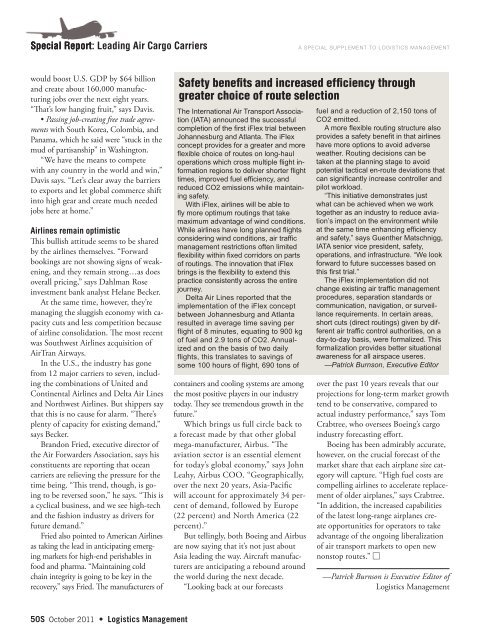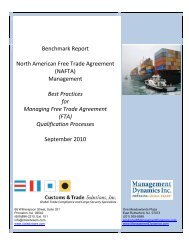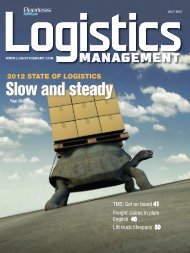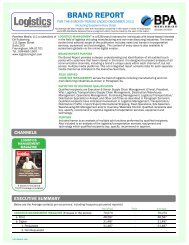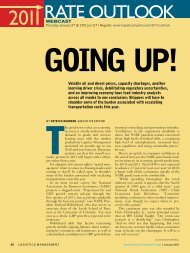Logistics Management - October 2011
Logistics Management - October 2011
Logistics Management - October 2011
Create successful ePaper yourself
Turn your PDF publications into a flip-book with our unique Google optimized e-Paper software.
Special Report: Leading Air Cargo CarriersA SPECIAL SUPPLEMENT TO LOGISTICS MANAGEMENTwould boost U.S. GDP by $64 billionand create about 160,000 manufacturingjobs over the next eight years.“That’s low hanging fruit,” says Davis.• Passing job-creating free trade agreementswith South Korea, Colombia, andPanama, which he said were “stuck in themud of partisanship” in Washington.“We have the means to competewith any country in the world and win,”Davis says. “Let’s clear away the barriersto exports and let global commerce shiftinto high gear and create much neededjobs here at home.”Airlines remain optimisticThis bullish attitude seems to be sharedby the airlines themselves. “Forwardbookings are not showing signs of weakening,and they remain strong…as doesoverall pricing,” says Dahlman Roseinvestment bank analyst Helane Becker.At the same time, however, they’remanaging the sluggish economy with capacitycuts and less competition becauseof airline consolidation. The most recentwas Southwest Airlines acquisition ofAirTran Airways.In the U.S., the industry has gonefrom 12 major carriers to seven, includingthe combinations of United andContinental Airlines and Delta Air Linesand Northwest Airlines. But shippers saythat this is no cause for alarm. “There’splenty of capacity for existing demand,”says Becker.Brandon Fried, executive director ofthe Air Forwarders Association, says hisconstituents are reporting that oceancarriers are relieving the pressure for thetime being. “This trend, though, is goingto be reversed soon,” he says. “This isa cyclical business, and we see high-techand the fashion industry as drivers forfuture demand.”Fried also pointed to American Airlinesas taking the lead in anticipating emergingmarkets for high-end perishables infood and pharma. “Maintaining coldchain integrity is going to be key in therecovery,” says Fried. The manufacturers ofSafety benefits and increased efficiency throughgreater choice of route selectionThe International Air Transport Association(IATA) announced the successfulcompletion of the first iFlex trial betweenJohannesburg and Atlanta. The iFlexconcept provides for a greater and moreflexible choice of routes on long-hauloperations which cross multiple flight informationregions to deliver shorter flighttimes, improved fuel efficiency, andreduced CO2 emissions while maintainingsafety.With iFlex, airlines will be able tofly more optimum routings that takemaximum advantage of wind conditions.While airlines have long planned flightsconsidering wind conditions, air trafficmanagement restrictions often limitedflexibility within fixed corridors on partsof routings. The innovation that iFlexbrings is the flexibility to extend thispractice consistently across the entirejourney.Delta Air Lines reported that theimplementation of the iFlex conceptbetween Johannesburg and Atlantaresulted in average time saving perflight of 8 minutes, equating to 900 kgof fuel and 2.9 tons of CO2. Annualizedand on the basis of two dailyflights, this translates to savings ofsome 100 hours of flight, 690 tons ofcontainers and cooling systems are amongthe most positive players in our industrytoday. They see tremendous growth in thefuture.”Which brings us full circle back toa forecast made by that other globalmega-manufacturer, Airbus. “Theaviation sector is an essential elementfor today’s global economy,” says JohnLeahy, Airbus COO. “Geographically,over the next 20 years, Asia-Pacificwill account for approximately 34 percentof demand, followed by Europe(22 percent) and North America (22percent).”But tellingly, both Boeing and Airbusare now saying that it’s not just aboutAsia leading the way. Aircraft manufacturersare anticipating a rebound aroundthe world during the next decade.“Looking back at our forecastsfuel and a reduction of 2,150 tons ofCO2 emitted.A more flexible routing structure alsoprovides a safety benefit in that airlineshave more options to avoid adverseweather. Routing decisions can betaken at the planning stage to avoidpotential tactical en-route deviations thatcan significantly increase controller andpilot workload.“This initiative demonstrates justwhat can be achieved when we worktogether as an industry to reduce aviation’simpact on the environment whileat the same time enhancing efficiencyand safety,” says Guenther Matschnigg,IATA senior vice president, safety,operations, and infrastructure. “We lookforward to future successes based onthis first trial.”The iFlex implementation did notchange existing air traffic managementprocedures, separation standards orcommunication, navigation, or surveillancerequirements. In certain areas,short cuts (direct routings) given by differentair traffic control authorities, on aday-to-day basis, were formalized. Thisformalization provides better situationalawareness for all airspace useres.—Patrick Burnson, Executive Editorover the past 10 years reveals that ourprojections for long-term market growthtend to be conservative, compared toactual industry performance,” says TomCrabtree, who oversees Boeing’s cargoindustry forecasting effort.Boeing has been admirably accurate,however, on the crucial forecast of themarket share that each airplane size categorywill capture. “High fuel costs arecompelling airlines to accelerate replacementof older airplanes,” says Crabtree.“In addition, the increased capabilitiesof the latest long-range airplanes createopportunities for operators to takeadvantage of the ongoing liberalizationof air transport markets to open newnonstop routes.” —Patrick Burnson is Executive Editor of<strong>Logistics</strong> <strong>Management</strong>50S <strong>October</strong> <strong>2011</strong> • <strong>Logistics</strong> <strong>Management</strong>


